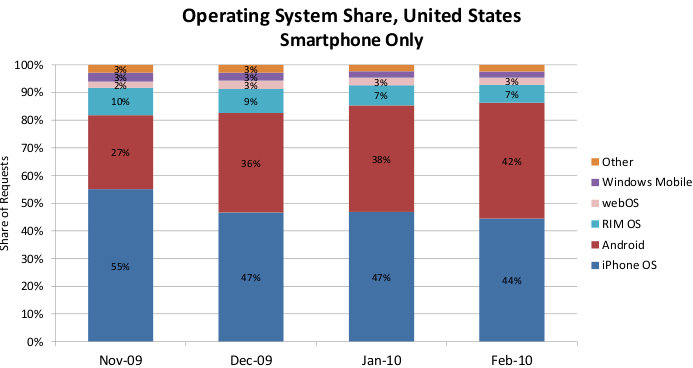 The iPhone has one major problem right now – over the past 4 months, it has lost 20% market share in the United States.
The iPhone has one major problem right now – over the past 4 months, it has lost 20% market share in the United States.
The iPhone craze from a couple of years ago seems is gone. So are the long lines of people standing outside the AT&T and Apple Stores. The $400 iPhones on Ebay have all but disappeared.
So what’s happening? How about the iPhone losing 20% marketshare in the OS space over the past 4 months.
Here’s the chart showing the declining marketshare of the iPhone in the US:

What’s causing the drop in market share?
I think the chart says it all… don’t you?
Google’s Android OS has been gaining market share. In fact, last month (Feb. 2010), Android has almost an equivalent share of the market as the iPhone (US only).
Plus, with the lack of flash support on the iPhone, and now on the iPad, I expect to see Apple’s market share continue to decline while Android continues to increase.
One of the advantages the Android phones have over the iPhone is their support for flash and also for HTML5 – a new code protocol that Apple says will replace flash.
But if Apple is claiming that HTML5 will replace Flash, then where are all the HTML5 supported apps for the iPhone?
With the rising share of the Android OS, Apple needs to start making HTML5 implementation a priority – especially considering the iPad is coming in just a few days.
21 replies on “iPhone Loses 20% Market Share in Past 4 Months (Chart)”
> The iPhone craze of 4 or so years ago
Huh? What iPhone were you using in March 2006?
> The iPhone craze of 4 or so years ago
Huh? What iPhone were you using in March 2006?
The chart DOES say a lot:
It takes a long list of different companies… making a large number of different (copy-cat) phones… to even come close the 1 phone: The iPhone.
The chart DOES say a lot:
It takes a long list of different companies… making a large number of different (copy-cat) phones… to even come close the 1 phone: The iPhone.
I was most impressed with the grammar in this article. Too bad Google doesn't have a better way of prioritizing and aggregating news search results, I'd like to be reading more relevant articles than this.
Hi Ken – I appreciate your feedback. I'm still new to blogging – this site is only 7 months old – so I'm working hard on improving my writing skills and ensuring I proof read before publishing, which I did not do with this article (unfortunately). I have to work especially hard at this now that my content is syndicating into Google News.
I did go back through it to edit.
Thanks again for visiting and commenting
Please learn how to read a graph! This is for total purchases for that time period. Not total market penetration like you’re implying in your article. Since you didn’t post your sources we don’t know if this is actually consumer requests or carrier requests.
If it’s consumer requests then you have to consider the company we're focusing on, Apple. They're very good at building hype each year with "new" products. You'll see a spike in sales during the summer, or whenever the product is released, and then the sales taper off as the next season rolls around. Customers are waiting for the next "new" product to drop. This has an effect on the carrier as well. They will decrease the amount of requests because consumers are waiting.
Please learn how to read a graph! This is for total purchases for that time period. Not total market penetration like you’re implying in your article. Since you didn’t post your sources we don’t know if this is actually consumer requests or carrier requests.
If it’s consumer requests then you have to consider the company we're focusing on, Apple. They're very good at building hype each year with "new" products. You'll see a spike in sales during the summer, or whenever the product is released, and then the sales taper off as the next season rolls around. Customers are waiting for the next "new" product to drop. This has an effect on the carrier as well. They will decrease the amount of requests because consumers are waiting.
Now if this chart is only referring to carrier requests then we need to look at how apple operates their business and how they fill orders. If they’re releasing new products during a coming season they drop their out-put to clear out their retailer’s supplies. This obviously makes room for the new product and helps reduce waste.
All of this is the basics of supply and demand however it gets tricky when we’re talking about ever updating technology. For instance your “proof” that demand is dwindling. The reason you don’t see anyone buying iphones for absurd prices on ebay anymore is due to the fact that Apple and AT&T saw this as an opportunity to make more money, by offering phones contract free! Not because demand is low but because they found a cheaper way to fill their demand.
Lastly, we need to consider that every member of the big four is carrying an android device. We now have a 4:1 ratio of android to iphone selling potentials. This has nothing to do with flash or HTML5!! You haven't shown a drop in market share so we have no idea if you're even correct! Please go back and fix this article with real market penetration numbers.
Uh? Smart Phone sales are expanding at an accelerated rate and Apples share of that exponentially expanding market may be slipping… but the sheer number of phones being sold by Apple is increasing rapidly and still way ahead of Android OS units. You will see the first quarter 2010 sales report from Apple will reflect record sales of their phone. Your framing of these statistics is grossly misleading and a distorted characterization of the smart phone market today. Android is definitely a major player and will challenge Apple… but I wouldn't say that these stats have the dire implications you write about.
I think Android has to do something in to advertising the product… I didnt hear this untill few days…they have to spend much on advertising..
Hi everybody ! For your information, the source is Admob, a mobile advertising agency and the % of request refers to the % of requests made from a given device or OS. Allthough it gives an indication of all the market powers, it should not be interpreted as (sales) market shares, all the more that only devices with applications embedding admob's adds are represented. However that may be, it is right to say that android is winning some market shares but not as was intrepreted here
Regards